There are things we can do to accidentally cause a brake pedal pulsation during normal brake service, but if this problem started on its own with no service work being done recently, the cause is usually a warped rotor, but a sticking caliper can do that too. The clue to a sticking caliper is the vehicle won't creep downhill easily on its own when you're in neutral, and that wheel will get very hot after a few miles.
A rotor can warp in different ways. One way will cause the brake pedal to pulsate up and down when pressure is applied. Another way might cause that, and might not, but it will cause the steering wheel to shimmy when the brakes are applied.
A rotor can be checked for warpage with a micrometer, a dial indicator, or by just placing it on the brake lathe and watching where the cutting bits remove material on the first pass. There is a published legal minimum thickness for every manufacturer and model. As long as the rotor will be above that minimum thickness when the machining is done, it can be reused, but in about the last 20 years we've been seeing some unusual brake pull problems when the two front rotors are not exactly the same thickness, especially on trucks. It's important that both rotors be machined to exactly the same thickness, and they must have the same speed of cut, so both front brakes develop exactly the same friction, meaning even stopping power.
Tuesday, January 20th, 2015 AT 4:41 PM




